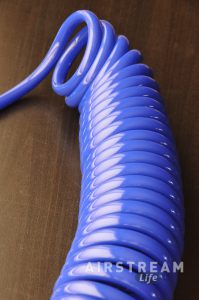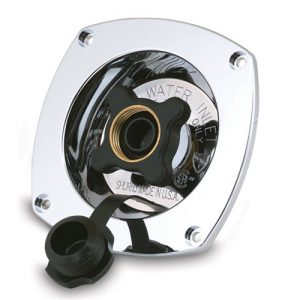 No.
No.
Was that too succinct?
OK, let me expand on that. If you have an Airstream made in the past four decades, and nobody has removed the built-in water pressure regulator, you don’t need one to protect the plumbing. That protection is already built in.
Honestly, I’m not sure why other manufacturers don’t build in pressure regulators. They’re not that expensive. I would never buy a new RV from a company that is too cheap to install a simple water pressure regulator. But apparently many do, because if you Google “RV water pressure regulator” you’ll find endless discussions about why you need one for Brand X, and all the awful things that could happen if you don’t get one.

Sometimes people suggest using a water pressure regulator to protect the typical vinyl “white water” hose, because it’s still potentially exposed to high water pressure at a campground spigot. I don’t see the logic in spending anywhere from $9 to $30 to protect a $30 hose. Especially since that hose won’t last more than a couple of years in average use anyway!
Instead, I bought a better hose that won’t ever be damaged by high pressure and will last for many years. In the long run it makes a lot more sense.
Things can be different for a vintage Airstream in which the plumbing has been replaced (as nearly all have). In this case it’s quite possible that the handyman who did the plumbing neglected to install a decent pressure regulator. Under really rare circumstances, you could have a plumbing problem as the result of excessively high water pressure.
I say “rare” because the common problem in campgrounds is low water pressure. When we find a campground with high pressure I’m always kind of happy about it, because it means great showers.
Really, a leak in the plumbing is far more likely to be the result of improper installation or winterizing than anything else. Just a little bit of water left in the wrong spot can result in a leak by springtime. (By the way, PEX is pretty good at resisting damage from freezing, which is one of the reasons the RV industry has gone over to it.)
 Still, if you find your Airstream has been “done over” by someone, check to see that a pressure regulator was installed. It should be very close to the city water fill (on the inside of the trailer), or more likely it’s integrated into the city water fill.
Still, if you find your Airstream has been “done over” by someone, check to see that a pressure regulator was installed. It should be very close to the city water fill (on the inside of the trailer), or more likely it’s integrated into the city water fill.
If it looks like the one at left (a Shurflo) then it has pressure regulation built-in, and you’re all set.
Bottom line: you probably don’t need another water pressure regulator.
This may be true for airstreams that don’t use the Alde system, (but it can’t hurt having one) I have days of proof at Jackson Center to fix pressure issues, mismatched regulators. I think they have addressed it now but the early Alde models had problems. I use an external adjustable regulator with a gauge about $30.00 – $50.00. For me it’s cheap insurance against failures, I set it at 40 PSI.
You’re right, there were some cases where the relief valve opened in an Airstream equipped with the Alde heating system. This will cause water to drain out of the Airstream. (Alde heating system is currently in use on some Classic trailers and Base Camp.)
The problem stemmed from the fact that the Shurflo water inlet was pre-set at 65 psi. This is fine for the bulk of the plumbing system, but the Alde relief valve is set to a lower pressure. So it was possible for the the relief valve on the Alde to open due to “high” water pressure at the campground. You’ll see water leaking out of the valve or a drain tube beneath the Airstream when this happens. To prevent this problem, Airstream now sets the Shurflo water regulator at 50 psi.
I have a 2006 that I purchased new and in the first 4 years of ownership I had to replace the city water inlet due to cracking twice. After the second replacement I started using a pressure regulator set to 50 PSI and have not had a failure since. The way I view it you’re spending $30 either way but with the stand alone pressure regulator you’re only doing it once.